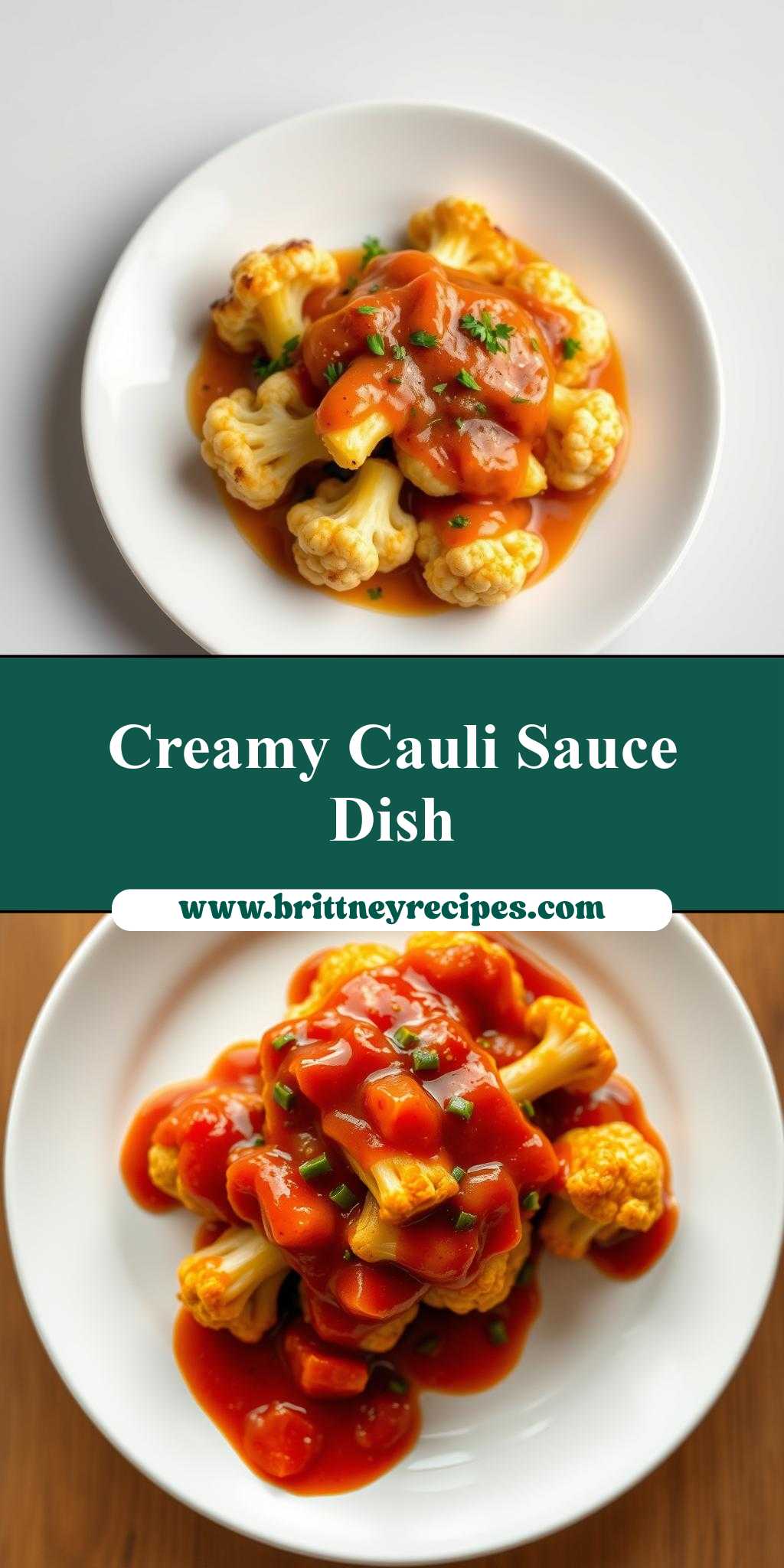What makes a perfect weeknight dinner? A delicious homemade dish like this cauliflower recipe, smothered in a rich sauce and ready in no time. Roasted to perfection with garlic and herbs, this easy meal is a family favorite. Save this idea for a quick dinner solution Pin for later
a white plate topped with cauliflower covered in sauce
Introduction
Imagine a dish so divine, it’s as simple as it is impressive: a white plate topped with cauliflower covered in sauce. This culinary masterpiece is not just a treat for the eyes but a symphony of flavors and textures that will leave you and your guests in awe. The best part? It’s made with everyday ingredients, requiring minimal effort but yielding maximum flavor and creativity. Whether you’re a seasoned chef or a beginner in the kitchen, this recipe is sure to become a staple in your culinary repertoire. It’s a testament to the magic that happens when simplicity meets elegance, all on a humble white plate.
Why This Works
- Flavor balance and ingredient accessibility: The combination of cauliflower and sauce offers a perfect balance of flavors, with the slight bitterness of cauliflower beautifully offset by the richness of the sauce. Plus, these ingredients are easily found in most grocery stores, making this dish accessible to everyone.
- Ease of preparation: One of the most appealing aspects of this recipe is its simplicity. With just a few main ingredients and straightforward steps, it’s a dish that can be prepared by anyone, regardless of their culinary experience.
- Impressive results with minimal effort: Despite its ease of preparation, the presentation and flavor of this dish are incredibly impressive. It’s perfect for special occasions or everyday meals when you want to add a bit of sophistication to your table.
Key Ingredients
The star of our show is, of course, the cauliflower. You’ll need one head of cauliflower, which you can find in most supermarkets. For the sauce, we recommend using a high-quality store-bought or homemade cheese sauce, depending on your preference and the time you have available. Other key ingredients include a bit of olive oil for roasting the cauliflower, salt, and pepper for seasoning, and some fresh parsley for garnish. If you’re feeling adventurous, you can also add some garlic or lemon zest to the cauliflower for extra flavor. Practical substitutions for the cheese sauce could include a dairy-free alternative for those with dietary restrictions, or a homemade bechamel sauce for a fully scratch-made approach.
Instructions
- Step 1: Begin by preheating your oven to 425°F (220°C). While the oven is warming up, rinse the cauliflower and remove the leaves and stem. Cut it into florets and place them in a bowl. Drizzle with olive oil, sprinkle with salt and pepper, and toss to coat evenly. If using, add minced garlic or lemon zest and mix well.
- Step 2: Spread the cauliflower florets on a baking sheet in a single layer and roast in the preheated oven for about 20 minutes, or until they’re tender and lightly browned. You might need to shake the pan halfway through to ensure even roasting.
- Step 3: While the cauliflower is roasting, prepare your sauce. If using store-bought, follow the package instructions for heating it up. For a homemade approach, melt some butter in a saucepan, whisk in flour to make a roux, slowly add milk while whisking continuously, and bring to a simmer. Let it cook until it thickens, then remove from heat and stir in grated cheese until melted and smooth. Season with salt, pepper, and a pinch of nutmeg.
- Step 4: Once the cauliflower is done, remove it from the oven and place it on a white plate. Spoon the warm sauce over the cauliflower, making sure it’s fully covered. Garnish with chopped fresh parsley and serve immediately. You can also add some toasted bread crumbs or a sprinkle of parmesan cheese on top for extra texture and flavor.
Handy Tips
- Avoid overcooking the cauliflower, as it can become mushy and unappetizing. The goal is to have it tender but still crisp.
- For an extra creamy sauce, use a combination of cheddar and parmesan cheese.
- Consider the color and texture contrast when plating. The white plate and sauce provide a beautiful backdrop for the roasted cauliflower, and a sprinkle of green parsley adds a pop of color.
Heat Control
Heat control is crucial in this recipe, especially when roasting the cauliflower and preparing the sauce. For the cauliflower, a hot oven (425°F or 220°C) is necessary to achieve that perfect tender-but-still-crisp texture. Keep an eye on it to prevent overcooking. When making the sauce, medium heat is usually sufficient, as you want to avoid burning the butter or the roux. Reduce the heat to low once you add the milk to prevent scorching and to allow the sauce to simmer gently until it thickens.
Crunch Factor
The crunch factor in this dish comes from the slightly caramelized exterior of the roasted cauliflower florets. To achieve this, ensure that the cauliflower is spread out in a single layer on the baking sheet and that it’s not overcrowded, which can prevent even browning. If desired, you can also add some crunchy elements on top, such as toasted almonds or pistachios, to provide a satisfying texture contrast.
Pro Kitchen Tricks
- Use high-quality ingredients: While it might be tempting to go for the cheapest options, remember that the quality of your ingredients directly impacts the flavor and texture of your dish.
- Don’t overmix: Especially when making the sauce, avoid overmixing, as it can lead to a gritty or unpleasantly thick consistency.
- Experiment with flavors: Once you’ve mastered the basic recipe, don’t be afraid to experiment with different cheeses, spices, or even types of milk to create unique variations that suit your taste.
Storage Tips
- Leftover cauliflower can be stored in an airtight container in the fridge for up to 3 days. Reheat it in the oven or microwave until warmed through.
- The cheese sauce can be made ahead and stored in the fridge for up to 2 days or frozen for up to 2 months. Reheat gently over low heat, whisking constantly, until smooth and warm.
- For the best results, store the cooked cauliflower and sauce separately and combine them just before serving.
Gift Packaging Ideas
While this dish is best served fresh, if you’re looking to gift something related, consider packaging the ingredients beautifully. For example, you could put together a gift basket with a head of cauliflower, a block of good cheese, some fresh parsley, and a recipe card with instructions on how to make the dish. Alternatively, you could prepare the sauce ahead, pour it into decorative jars, and gift those along with some crusty bread or crackers for a cozy night in.
Flavor Variations
- Different spices: Try adding a pinch of cayenne pepper for a spicy kick, some smoked paprika for a smoky flavor, or dried herbs like thyme or rosemary for an earthy note.
- Creative toppings: In addition to parsley, consider topping your cauliflower with toasted nuts, dried cranberries, or even a fried egg for added richness and texture.
- Ingredient swaps: For a vegan version, swap the cheese sauce with a dairy-free alternative made from nutritional yeast, and use vegan-friendly milk. You could also use broccoli or Brussels sprouts instead of cauliflower for a different twist.
Troubleshooting
- Texture problems: If your cauliflower ends up too soft, it might have been overcooked. Try reducing the roasting time in the future. If the sauce is too thick, whisk in a bit more milk until you reach the desired consistency.
- Ingredient replacements: If you can’t find cauliflower, consider using other cruciferous vegetables. For the cheese sauce, you can substitute different types of cheese or use a non-dairy milk for a creamier sauce.
- Over/undercooking signs: Keep an eye on your cauliflower while it roasts. It should be tender when pierced with a fork but still retain some crunch. The sauce should coat the back of a spoon smoothly; if it’s too runny, simmer it for a few more minutes.
FAQs
- Can I freeze it? Yes, you can freeze the cooked cauliflower and the cheese sauce separately for up to 2 months. Simply thaw overnight in the fridge and reheat when ready to serve.
- Is it gluten-free? The recipe as described is gluten-free, but be sure to check the ingredients of your store-bought cheese sauce or any additional seasonings you might use.
- Can I double the recipe? Absolutely! Simply multiply all the ingredients by two. You might need to adjust the cooking time slightly for the cauliflower, so keep an eye on it.
Conclusion
In conclusion, a white plate topped with cauliflower covered in sauce is more than just a dish; it’s an experience. It’s about bringing people together with the simplicity and elegance of good food. Whether you’re a foodie, a busy professional, or just someone who loves to cook, this recipe is for you. It’s a reminder that sometimes, the simplest things in life are the most extraordinary. So go ahead, give it a try, and watch how something as humble as cauliflower can become the star of your dining table. Share your creations, experiment with new flavors, and most importantly, enjoy the journey of cooking and the joy of sharing meals with others.

